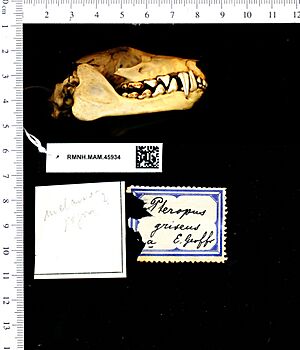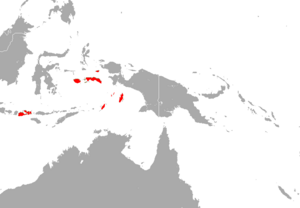Black-bearded flying fox facts for kids
Quick facts for kids Black-bearded flying fox |
|
|---|---|
 |
|
| Conservation status | |
| Scientific classification | |
| Genus: |
Pteropus
|
| Species: |
melanopogon
|
 |
|
| Black-bearded flying fox range (map also includes range of Aru Flying Fox and Kei Flying Fox) | |
| Synonyms | |
The black-bearded flying fox (Pteropus melanopogon) is a special kind of bat that lives in Indonesia. It's called a "flying fox" because its face looks a bit like a fox! This large bat is an endangered animal, which means there aren't many left in the wild. It can only be found on a few islands in Indonesia, like Seram.
Contents
About Its Name and Family
This flying fox was first described in 1867 by a German scientist named Wilhelm Peters. Its scientific name, melanopogon, comes from two old Greek words. "Melas" means "black," and "pogon" means "beard." So, its name literally means "black beard," which fits its appearance!
The black-bearded flying fox belongs to a group of large bats called megabats. It's part of the Pteropus genus, which has many different species. Some of its close relatives include:
- Aru flying fox (Pteropus aruensis)
- Kei flying fox (Pteropus keyensis)
What Does It Look Like?
The black-bearded flying fox is a pretty big bat! Adults can weigh between 510 and 900 grams (about 1 to 2 pounds). This makes it one of the heavier bats in its family.
Its fur has some interesting colors. On its face, between its eyes, and under its jaw, the fur is dark red. Its head, neck, and shoulders are a bright reddish-brown. The hairs on its body are two-colored: pale yellow at the bottom and darker at the tip. Its back is mostly dark brown, with some bright yellow hairs scattered around. The skin between its legs, called the uropatagium, is covered with long, dark brown fur.
Its forearms are quite long, about 175 to 193 millimeters (7 to 7.6 inches). Unlike many bats, its wings attach closer to its spine, not just the sides of its body. Its legs and forearms don't have fur.
How It Lives
The black-bearded flying fox likes to eat flowers from durian trees. It's a very social animal and lives in large groups called colonies. These colonies can have up to 200 bats! Usually, all the bats in a colony are the same species. However, they have sometimes been seen roosting near Moluccan flying foxes, though not in the same tree.
Where It Lives
This flying fox is only found in the Maluku Islands in Indonesia. Sadly, there's only one known colony left. This last group of bats lives in mangrove forests on Seram Island.
In the past, these bats lived on other islands too, like Ambon, Buru, Banda, and Yamdena. But there haven't been any recent sightings on those islands.
Why It Needs Our Help
Back in the 1800s, there were many black-bearded flying foxes. But now, they are an endangered animal. The IUCN has given them this status because their numbers have dropped so much.
Today, there's only one known colony left, with fewer than 200 bats. This species is not protected by law, and the forest where they live isn't protected either. Scientists believe their population could drop by half between 2016 and 2049.
The biggest dangers to these bats are:
- Habitat destruction: People are cutting down their forest homes, especially through deforestation.
- Overhunting: These bats are hunted for bushmeat. Because they live in large colonies, it's easy for hunters to catch many at once, which makes their population shrink very quickly.
We need to protect these unique bats and their homes so they don't disappear forever!
Images for kids




